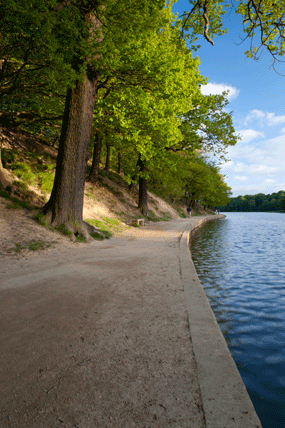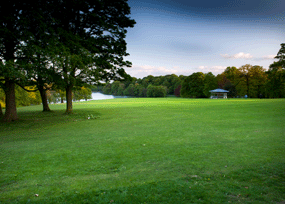Roundhay Park – Leeds’s Favourite Green Space

A Park for All Seasons
by Barney Bardsley
Roundhay Park is fondly regarded by the citizens of Leeds as one of the jewels in West Yorkshire’s crown and it is easy to see why. Following an £8 million millennium makeover from the Heritage Lottery fund, its 700 acres of undulating woodland and open green space, complete with two lakes, fountain, waterfall and tumbling streams, positively glow with elegance and good health. When I first moved to Leeds in 1996, I was lucky enough to land on Roundhay’s doorstep, and have lived nearby ever since, watching the park change and evolve. It is a constant source of delight.
 As for so many local people, Roundhay Park has become a place by which I measure memories and associations. From pacing the fence by the playground, waiting for my (then) four year old to get off the slide, to leading a crocodile of primary school children down to Tropical World – the exotic bug and butterfly house opposite the park in Canal Gardens. From walking my young dog round the huge and beautiful Waterloo Lake, flanked on one side by a steep bank of trees, and on the other by a curving expanse of green hills, rising up to meet the sky, to walking that same dog, now elderly, around the smaller Upper Lake, and rescuing her from an angry mother swan. (Despite their vicious parent – the cygnets were divine.)
As for so many local people, Roundhay Park has become a place by which I measure memories and associations. From pacing the fence by the playground, waiting for my (then) four year old to get off the slide, to leading a crocodile of primary school children down to Tropical World – the exotic bug and butterfly house opposite the park in Canal Gardens. From walking my young dog round the huge and beautiful Waterloo Lake, flanked on one side by a steep bank of trees, and on the other by a curving expanse of green hills, rising up to meet the sky, to walking that same dog, now elderly, around the smaller Upper Lake, and rescuing her from an angry mother swan. (Despite their vicious parent – the cygnets were divine.)
“Riot of red, orange and yellow”
There’s more… Tramping the heights of Hill 60, year after year, to watch the wild bonfire on November 5th. Supping a pint or two at the Roundhay Fox, a lovely building of Yorkshire stone which flanks the park and forms part of the old estate. And dropping my daughter off at the same pub on Christmas Eve –no longer four, but 18, and lacing her fizzy pop with rum! The park sees it all, with silent amusement.
“Every time I drive up this road, I feel my spirits lift.” This is a colleague, talking about Princes Avenue, the wide former tramway which sweeps up from Oakwood Clock junction towards the main park gates. With Soldiers Fields, green and flat, on either side, there is an immediate sense of space and calm: both qualities rare in a city, and precious. It is here that the seasons start to be measured. First, the thousands of purple, yellow and white crocuses, which line the kerb in early spring.
Then the daffodils on the banks further up, as March takes hold. In the summer heat – go further in, to the thick woodland along the secret ravine at the wilder edges of the park, offering dense cover, shade and solitude. In autumn the big lake is the place to be: its trees show off like mad as their leaves turn into a riot of red, orange, copper and yellow. And in winter? It’s pleasingly bleak up on the tops. A good place to shake off a New Year hangover. And when there’s snow: there’s always the tobogganing down Hill 60 (but if you value your life, don’t do it.)
“Kitsch castle folly”
Despite its recent glossy makeover, Roundhay Park is an ancient piece of land. In prehistoric times there were swamps and rainforests here. The rotting vegetation formed rich geological layers of coal, iron ore and timber. When this was extracted during the Middle Ages, deep quarries were left. These filled up with water to create ponds (later developed into the large lakes). In the 13th century, William the Conqueror gave the land to the De Lacy family. They used its lush grassland for deer grazing and hunting. Then Charles I took it over in 1625, but only for three years: he had to sell it to discharge his debts. He couldn’t hold on to his land, or his head….
It was the 19th century when the Park entered its first golden age. Thomas Nicholson bought the entire estate and spent many years developing its natural features. The ravines, the lakes, the woodland walks – and commissioning its striking buildings – the Greek Revival-style mansion (now a top end restaurant) and the wonderfully kitsch castle folly (used by the Nicholson family for picnics on the roof in summer). In 1871 the Nicholson line came to an end. There was no male heir. The estate had to be sold once more. This time – to the City of Leeds.
 It was the Lord Mayor of Leeds, John Barran, who took the bold step of buying the Park in 1872 for the public good. At the time he was widely ridiculed for spending so much on this “white elephant” of a place. It was too far out for the ordinary folk – from the tenements and factories of south Leeds – to come and visit. But he had the last laugh.
It was the Lord Mayor of Leeds, John Barran, who took the bold step of buying the Park in 1872 for the public good. At the time he was widely ridiculed for spending so much on this “white elephant” of a place. It was too far out for the ordinary folk – from the tenements and factories of south Leeds – to come and visit. But he had the last laugh.
“Artful landscaping”
Tramlines were built in 1891, and people came in their droves. And still they come! During the Victorian era all sorts of extravagant events were staged. Mock battles on the lake, a paddle steamer for Sunday trips, tight rope walking on the upper water. We have become a little more demure in this modern age. But still – the Arena has rocked out since the eighties to the strains of Bruce Springsteen and the Stones, Michael Jackson and Madonna. There are melas and fairs and festivals. And the bonfire and fireworks burn every November. Leaving streets gridlocked with cars and teeming with people. They come from all over to get mud on their boots and gunpowder up their noses.
Everyone who knows Roundhay Park will have a favourite spot, a particular memory. Crowd lovers will flock to the big “happenings”, the wide open spaces, the two cafes and lakeside walks. But for me it’s the secret, hidden park that is the most magical. Early in the morning. Weekdays. Just a few joggers and dog walkers blowing on their hands to keep warm. Wandering off the beaten track then, into the woods, along the ravine, by the running water, you can imagine the swamps and the rainforests from thousands of years ago, still breathing, still alive. In the artful landscaping and carefully nurtured scenery: the wildness remains.
“A Handful of Earth” by Barney Bardsley is published by John Murray
Pictures Steve Stenson










Roundhay Park: A Park for All Seasons by Barney Bardsley … http://t.co/meWSSgZ3 #leeds #yorkshire